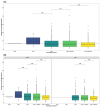Long COVID at Different Altitudes: A Countrywide Epidemiological Analysis
- PMID: 36429392
- PMCID: PMC9690364
- DOI: 10.3390/ijerph192214673
Long COVID at Different Altitudes: A Countrywide Epidemiological Analysis
Abstract
Background: Several reports from around the world have reported that some patients who have recovered from COVID-19 have experienced a range of persistent or new clinical symptoms after a SARS-CoV-2 infection. These symptoms can last from weeks to months, impacting everyday functioning to a significant number of patients.
Methods: A cross-sectional analysis based on an online, self-reporting questionnaire was conducted in Ecuador from April to July 2022. Participants were invited by social media, radio, and TV to voluntarily participate in our study. A total of 2103 surveys were included in this study. We compared socio-demographic variables and long-term persisting symptoms at low (<2500 m) and high altitude (>2500 m).
Results: Overall, 1100 (52.3%) responders claimed to have Long-COVID symptoms after SARS-CoV-2 infection. Most of these were reported by women (64.0%); the most affected group was young adults between 21 to 40 years (68.5%), and most long-haulers were mestizos (91.6%). We found that high altitude residents were more likely to report persisting symptoms (71.7%) versus those living at lower altitudes (29.3%). The most common symptoms were fatigue or tiredness (8.4%), hair loss (5.1%) and difficulty concentrating (5.0%). The highest proportion of symptoms was observed in the group that received less than 2 doses.
Conclusions: This is the first study describing post-COVID symptoms' persistence in low and high-altitude residents. Our findings demonstrate that women, especially those aging between 21-40, are more likely to describe Long-COVID. We also found that living at a high altitude was associated with higher reports of mood changes, tachycardia, decreased libido, insomnia, and palpitations compared to lowlanders. Finally, we found a greater risk to report Long-COVID symptoms among women, those with previous comorbidities and those who had a severer acute SARS-CoV-2 infection.
Keywords: COVID-19; Latin America; SARS-CoV-2; high altitude; long-COVID; sequalae; symptoms.
Conflict of interest statement
The authors declare that they have no known competing financial interests or personal relationships that could have appeared to influence the work reported in this paper.
Figures






References
-
- Worobey M., Levy J.I., Serrano L.M., Crits-Christoph A., Pekar J.E., Goldstein S.A., Rasmussen A.L., Kraemer M.U., Newman C., Koopmans M.P., et al. The Huanan Seafood Wholesale Market in Wuhan was the early epicenter of the COVID-19 pandemic. Science. 2022;377:951–959. doi: 10.1126/science.abp8715. - DOI - PMC - PubMed
-
- Chippa V., Aleem A., Anjum F. StatPearls. StatPearls Publishing; Treasure Island, FL, USA: 2021. [(accessed on 22 July 2022)]. Post Acute Coronavirus (COVID-19) Syndrome. Available online: https://www.ncbi.nlm.nih.gov/books/NBK570608/
-
- Ortiz-Prado E., Simbaña-Rivera K., Gómez-Barreno L., Rubio-Neira M., Guaman L.P., Kyriakidis N.C., Muslin C., Gómez A.M., Barba-Ostria C., Cevallos-Robalino D., et al. Clinical, molecular and epidemiological characterization of the SARS-CoV2 virus and the Coronavirus disease 2019 (COVID-19), a comprehensive literature review. Diagn. Microbiol. Infect. Dis. 2020;98:115094. doi: 10.1016/j.diagmicrobio.2020.115094. - DOI - PMC - PubMed
-
- PAHO PAHO Weekly COVID-19 Epidemiological Update-27 September 2022-PAHO/WHO|Pan American Health Organization. [(accessed on 6 October 2022)]. Available online: https://www.paho.org/en/documents/paho-weekly-covid-19-epidemiological-u....
MeSH terms
LinkOut - more resources
Full Text Sources
Medical
Miscellaneous

